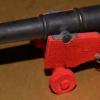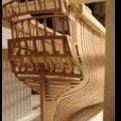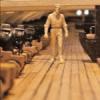-
Posts
1,763 -
Joined
-
Last visited
Reputation Activity
-
 Mark P got a reaction from druxey in Inserting scanned object
Mark P got a reaction from druxey in Inserting scanned object
Hi Fatfingers;
Thank you for your patience and the further guidance on how to do this. I am very happy to learn from you.
I will purchase a copy of Inkscape, and set to work.
I thought I recognised the background in your post! If you are building a model of Royal Caroline, then for God's sake talk to me before you go any further, especially if you are using Sergio Bellabarba's book as a guide (it was his book that piqued my interest in her, but as soon as I did even a modicum of research, I realised that his book is riddled with errors. It is easier to list what he has got right than it is to list what he has got wrong!)
Full credit to him though for a beautifully illustrated book. And research is undoubtedly much easier now than it was. But some of the errors are so obvious and so easily avoided that it is not easy to remain polite.
All the best,
Mark P
-
 Mark P got a reaction from Canute in THE 74-GUN SHIP by Jeronimo
Mark P got a reaction from Canute in THE 74-GUN SHIP by Jeronimo
I have to agree. A real quality piece of craftsmanship!
-
 Mark P got a reaction from Jeronimo in THE 74-GUN SHIP by Jeronimo
Mark P got a reaction from Jeronimo in THE 74-GUN SHIP by Jeronimo
Hi Karl;
Congratulations on a beautifully constructed model.
Does the construction method of the frames mirror full-size contemporary French practice? If so, it is interesting to note the differences from English techniques at the time.
All the best,
Mark P
-
 Mark P got a reaction from mtaylor in Inserting scanned object
Mark P got a reaction from mtaylor in Inserting scanned object
Hi Fatfingers;
Your help has been invaluable. Thank you again.
I too look forward to reading the results. But it will be a while yet!
All the best,
Mark P
-
 Mark P got a reaction from mtaylor in Inserting scanned object
Mark P got a reaction from mtaylor in Inserting scanned object
Hi Fatfingers;
Thank you for your patience and the further guidance on how to do this. I am very happy to learn from you.
I will purchase a copy of Inkscape, and set to work.
I thought I recognised the background in your post! If you are building a model of Royal Caroline, then for God's sake talk to me before you go any further, especially if you are using Sergio Bellabarba's book as a guide (it was his book that piqued my interest in her, but as soon as I did even a modicum of research, I realised that his book is riddled with errors. It is easier to list what he has got right than it is to list what he has got wrong!)
Full credit to him though for a beautifully illustrated book. And research is undoubtedly much easier now than it was. But some of the errors are so obvious and so easily avoided that it is not easy to remain polite.
All the best,
Mark P
-
 Mark P got a reaction from mtaylor in Inserting scanned object
Mark P got a reaction from mtaylor in Inserting scanned object
Hi Fatfingers;
Many thanks for all your help. I am very grateful for the trouble you have gone to to answer my query.
The explanation of bitmap vs drawing file is very helpful. I have not used bitmap much, and I will certainly not for this project.
My scanner only gives the option of bitmap, JPEG, PDF or TIFF files. Will a TIFF be okay to load into Inkscape, and convert to an SVG file.
If not, then I will have to get a new scanner, one which offers PNG as an output option.
Is conversion to SVG sufficient to create the transparent appearance, or do I still need to set white to transparent.
Once again, many thanks for your help.
All the best,
Mark P
-
 Mark P got a reaction from mtaylor in Inserting scanned object
Mark P got a reaction from mtaylor in Inserting scanned object
Hi Fatfingers;
Wow! I have just seen your alteration to my picture. I hadn't seen it when I posted the above reply.
That's just what I want to do. How did you do that? It's like magic!
Many thanks,
Mark P
-
 Mark P got a reaction from mtaylor in Inserting scanned object
Mark P got a reaction from mtaylor in Inserting scanned object
Hi Fatfingers;
Many thanks for the post.
I can vary the image format from the scanner, if I know what type to save it as in advance.
Can you explain the difference between a drawing and a bitmap. Scaleability is important, so it sounds as though I need to look at Inkscape.
Thanks again.
All the best,
Mark P
-
 Mark P got a reaction from mtaylor in Inserting scanned object
Mark P got a reaction from mtaylor in Inserting scanned object
Hi Allan;
Thank you for your reply. The attachment is based on a detail from the draught (none of the other carvings are shown on it)
I have drawn it on a sheet of A4 paper, and when I scan it, the scan is rectangular in shape. Even if I drew it on clear film, the result would be the same, as a scan will still be rectangular, and will pick up the white background of the scanner lid.
I attach an example of this imported into the CAD drawing.
Thank you for looking at this.
All the best,
Mark P
-
 Mark P got a reaction from mtaylor in Wooden Warship Construction: A History in Ship Models-
Mark P got a reaction from mtaylor in Wooden Warship Construction: A History in Ship Models-
Hi Druxey;
Thank you for the post. I was not aware that they co-operate sometimes.
All the best,
Mark P
-
 Mark P reacted to Chuck in Wooden Warship Construction: A History in Ship Models-
Mark P reacted to Chuck in Wooden Warship Construction: A History in Ship Models-
That is the Winchelsea on the cover......its a nice coffee table book. Lots of photos.
Chuck
-
 Mark P reacted to druxey in Wooden Warship Construction: A History in Ship Models-
Mark P reacted to druxey in Wooden Warship Construction: A History in Ship Models-
Mark: often Seaforth and the NIP both publish the same book under their own imprint, but on different sides of the Atlantic.
-
 Mark P got a reaction from mtaylor in Wooden Warship Construction: A History in Ship Models-
Mark P got a reaction from mtaylor in Wooden Warship Construction: A History in Ship Models-
Hi Frankie;
Thanks for posting this. I too have the others, and they are excellent. The frigate and ship of the line books were published by Seaforth, a wide ranging military/naval specialist. This book is available for pre-order on Amazon uk, but I notice it is published by the US Naval Institute Press. Presumably the author got a better offer!
All the best,
Mark P
-
 Mark P reacted to JerseyCity Frankie in Wooden Warship Construction: A History in Ship Models-
Mark P reacted to JerseyCity Frankie in Wooden Warship Construction: A History in Ship Models-
Came across this on Amazon, not yet published but it looks like it will be the next book in the "A History in Ship Models" series that is being issued by the National Maritime Museum. The titles issued in the series are thus far The Ship of the Line by Brian Levery, The Sailing Frigate by Robert Gerdiner and Warships of the Great War Era by David Hobbs. I have the three currently available and I am excited to get my hands on this new offering as soon as it becomes available. The books in this series feature dozens of excellent clear very sharp photos of great representative models from the Museums collections, used to illustrate the history of the subject. The text is pretty good if brief, the editors wisely erred on the side of good glossy illustrations and the text provides the historical overview with enough detail to satisfy but without overburdening readers like myself who are really just there for the rich imagery.
https://www.amazon.com/dp/1473894808/sr=1-47/qid=1476528251/ref=olp_product_details?_encoding=UTF8&me=&qid=1476528251&sr=1-47
-
 Mark P got a reaction from mtaylor in Thinking things through: Scuttles on the deck of British first rates (and perhaps other ships)
Mark P got a reaction from mtaylor in Thinking things through: Scuttles on the deck of British first rates (and perhaps other ships)
Greetings Dafi;
The top ropes were used to raise and lower the topmasts.
Prior to 1800 (according to Lees) the top ropes were not unrove once the topmast was in position, but were a permanent feature of the rigging. This was probably because in stormy weather it was a not uncommon procedure to lower the topmasts to reduce top-hamper, as shown in several paintings I have seen.
I would imagine that your thought that this is to allow for a lead to the capstan to be quite correct.
I have only seen the scuttles before on third rates. So as Druxey says above, they probably only appeared aft of other masts on first rates, although perhaps on second rates also.
Thanks for passing on your observations.
All the best,
Mark P
PS: I always think it is such a shame that the beautiful carved work to the stern and the bows was ripped off just before Trafalgar. If only they had done it afterwards. She was a much more attractive ship prior to the alterations.
-
 Mark P got a reaction from dafi in Thinking things through: Scuttles on the deck of British first rates (and perhaps other ships)
Mark P got a reaction from dafi in Thinking things through: Scuttles on the deck of British first rates (and perhaps other ships)
Greetings Dafi;
The top ropes were used to raise and lower the topmasts.
Prior to 1800 (according to Lees) the top ropes were not unrove once the topmast was in position, but were a permanent feature of the rigging. This was probably because in stormy weather it was a not uncommon procedure to lower the topmasts to reduce top-hamper, as shown in several paintings I have seen.
I would imagine that your thought that this is to allow for a lead to the capstan to be quite correct.
I have only seen the scuttles before on third rates. So as Druxey says above, they probably only appeared aft of other masts on first rates, although perhaps on second rates also.
Thanks for passing on your observations.
All the best,
Mark P
PS: I always think it is such a shame that the beautiful carved work to the stern and the bows was ripped off just before Trafalgar. If only they had done it afterwards. She was a much more attractive ship prior to the alterations.
-
 Mark P got a reaction from mtaylor in Rigging bunt lines, clew lines, sheets - Cutty Sark (edited by Admin)
Mark P got a reaction from mtaylor in Rigging bunt lines, clew lines, sheets - Cutty Sark (edited by Admin)
Hi Macgoodwin;
If the sails were removed for a shortish period of time, normal practice was to join together the lines which would have been attached to the clew of the sail, and pull them up to the yard. Buntlines would be made fast to the strop of their block on the yard (or perhaps to the jack-line, if these were fitted to the Cutty Sark)
The idea was to save time when bending the sails to the yard. Re-reeving ropes took much longer than simply re-attaching them.
The attached picture (contemporary rigged model, in the Science Museum Archive since 1881) shows this in a much earlier, Naval, not merchant vessel; but if the Navy, with high manning levels, did this, then it would seem very reasonable to expect the merchant ships, with a smaller crew and time/profit considerations driving them, to be even more likely to take the route that saved time/money.
The picture shows the sheet, tack and clew blocks all pulled up to the yard. Buntlines are visible coming from the lead blocks under the top.
All the best,
Mark P
-
 Mark P got a reaction from Archi in HMS Terror found!
Mark P got a reaction from Archi in HMS Terror found!
Thanks Druxey;
Having seen your post, I had a look, and there are some interesting news articles about it on line.
All the best,
Mark P
-
 Mark P got a reaction from WackoWolf in THE 74-GUN SHIP by Jeronimo
Mark P got a reaction from WackoWolf in THE 74-GUN SHIP by Jeronimo
I have to agree. A real quality piece of craftsmanship!
-
 Mark P got a reaction from mtaylor in THE 74-GUN SHIP by Jeronimo
Mark P got a reaction from mtaylor in THE 74-GUN SHIP by Jeronimo
I have to agree. A real quality piece of craftsmanship!
-
 Mark P got a reaction from Jeronimo in THE 74-GUN SHIP by Jeronimo
Mark P got a reaction from Jeronimo in THE 74-GUN SHIP by Jeronimo
I have to agree. A real quality piece of craftsmanship!
-
 Mark P got a reaction from CaptainSteve in THE 74-GUN SHIP by Jeronimo
Mark P got a reaction from CaptainSteve in THE 74-GUN SHIP by Jeronimo
I have to agree. A real quality piece of craftsmanship!
-
 Mark P got a reaction from zoly99sask in THE 74-GUN SHIP by Jeronimo
Mark P got a reaction from zoly99sask in THE 74-GUN SHIP by Jeronimo
I have to agree. A real quality piece of craftsmanship!
-
 Mark P got a reaction from Canute in THE 74-GUN SHIP by Jeronimo
Mark P got a reaction from Canute in THE 74-GUN SHIP by Jeronimo
Hi Karl;
Congratulations on a beautifully constructed model.
Does the construction method of the frames mirror full-size contemporary French practice? If so, it is interesting to note the differences from English techniques at the time.
All the best,
Mark P
-
 Mark P got a reaction from mtaylor in What are these? does anybody knows? thanks.....
Mark P got a reaction from mtaylor in What are these? does anybody knows? thanks.....
Greetings Gerard;
Many thanks for the explanation. That's completely logical once it is made clear, as with so many things.
All the best,
Mark P









